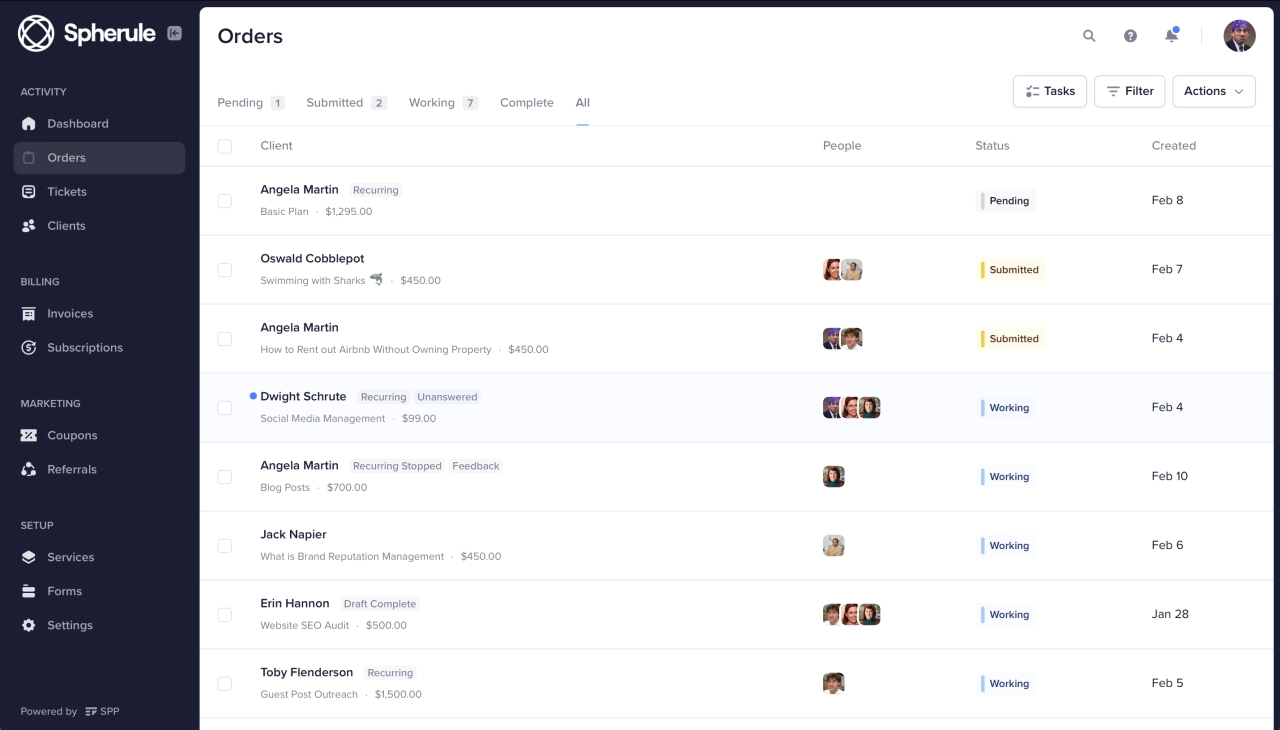- Establishing clear communication channels and setting expectations early on can help prevent clients from canceling services.
- Continuously providing value and demonstrating expertise in your field can help retain clients and prevent them from seeking out competitors.
- Regularly soliciting feedback from clients can help you identify areas for improvement and make adjustments to better meet their needs.
Service businesses overwhelmingly report spending more on new client acquisition than account retention. Yet most of them say return on investment would be better with the opposite.
What’s the root of this phenomenon? Perhaps agencies feel uncomfortable thinking critically about the effectiveness of their own services. Thus, they withdraw to a fatalist assumption: The right clients stay; the others will inevitably churn.
Let’s take a look why you should have a solid agency client retention strategy. I’ll also introduce you to 5 strategies to keep your customer retention period high.
Why agencies should focus on retaining clients
Client-agency fit can be hard to predict at the start of an engagement. But you can influence the momentum factor. You can improve the chances that undecided clients will renew, and earn your agency time to show its value.
Do you know the lifetime value (CLV) of each of your active and past clients? Your average cost of acquisition (CAC)? If you have a high-touch sales model, don’t indulge in a fantasy that it’s a temporary state of affairs. What are your plans to change it?
For productized agencies, decreasing CAC is an attractive prize. But if CLV is decreasing in proportion, all that extra value is leaking. What about the reverse approach? If you make a high average CLV the foundation of your business, CAC becomes a flexible growth center.
The longer a client stays with you, the higher their life expectancy becomes.
Long-term clients also provide amazing referral and case study opportunities. Even when demand is high, thinking “we can always find more clients” is like playing with fire. When crises emerge, it’s your loyal clients that keep you alive.
3 reasons your clients are leaving your agency
Many agencies don’t know why clients are leaving them. They just assume they found a new business provider that is simply better. Could they have done anything to prevent them from leaving? Most likely.
Let’s look at a few reasons agencies often loose clients.
Price: You advertised yourself as a premium agency, so you have above-average prices. Clients try you out, but find your prices simply too high. This could either be a problem with your pricing strategy, or the leads you attract. Or, you are not delivering the right quality.
Quality: The quality is often linked to your pricing. If you price yourself highly, you need to deliver high quality, too. But even if your prices are reasonable, low-quality work will lead to customers churning.
Communication: If your clients need to follow up every time, they won’t stick around. Communicating well is an art in itself. Put processes in place that automate communication for repeating tasks. For instance, set up an automation with Zapier when an order status in SPP changes, and send an automated message to your client.
These are just three common reasons your losing customers. There are many more that depend on the type of business you do, for instance changes in your company structure, a focus on B2B clients, or losing some of your best talent.
Client retention strategies for agencies
Now that you know why you might loose an existing customer, let’s look at a few strategies to improve client relationships, and to ensure that you have more repeat customers.
Make it painless to keep paying for your services
The typical services purchasing model is expensive for both parties. Sending proposals and service orders back and forth via email is becoming anachronistic. Even big old enterprises now rely on subscription services in at least some areas.
Time and mental bandwidth are scarce resources for your client. Anything you do to remove friction from the purchasing process makes you more attractive to keep working with.
Having account managers negotiate renewals and take responsibility for contracts might demonstrate attentiveness. It might make it possible to identify and resolve problems early. But such a hands-on approach is also demanding for the client.
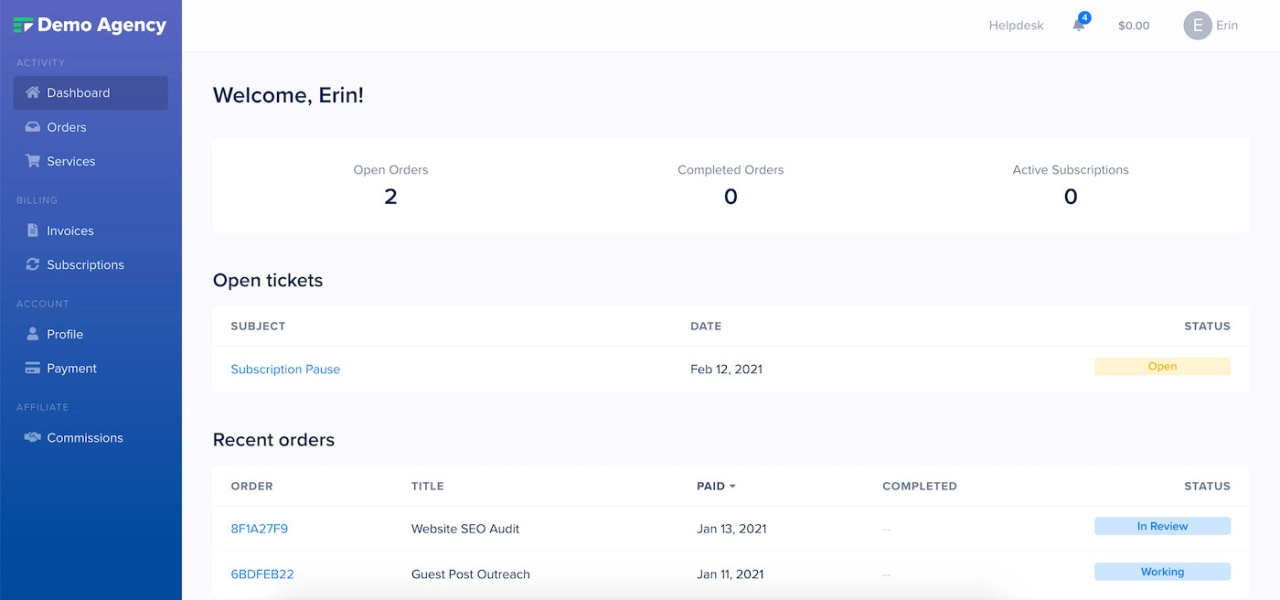
A productized setup, with a self-service checkout and billing built into a portal, gives clients a greater sense of control. If you offer premium services, you can maintain a high level of personal touch. The difference is you don’t always have to be a salesperson. You have the option to take a no pressure approach, or ask directly. It depends on what’s appropriate for each situation.
This model does away with friction on your side as well. You can move resources to delivery. Client conversations become focused on results rather than admin.
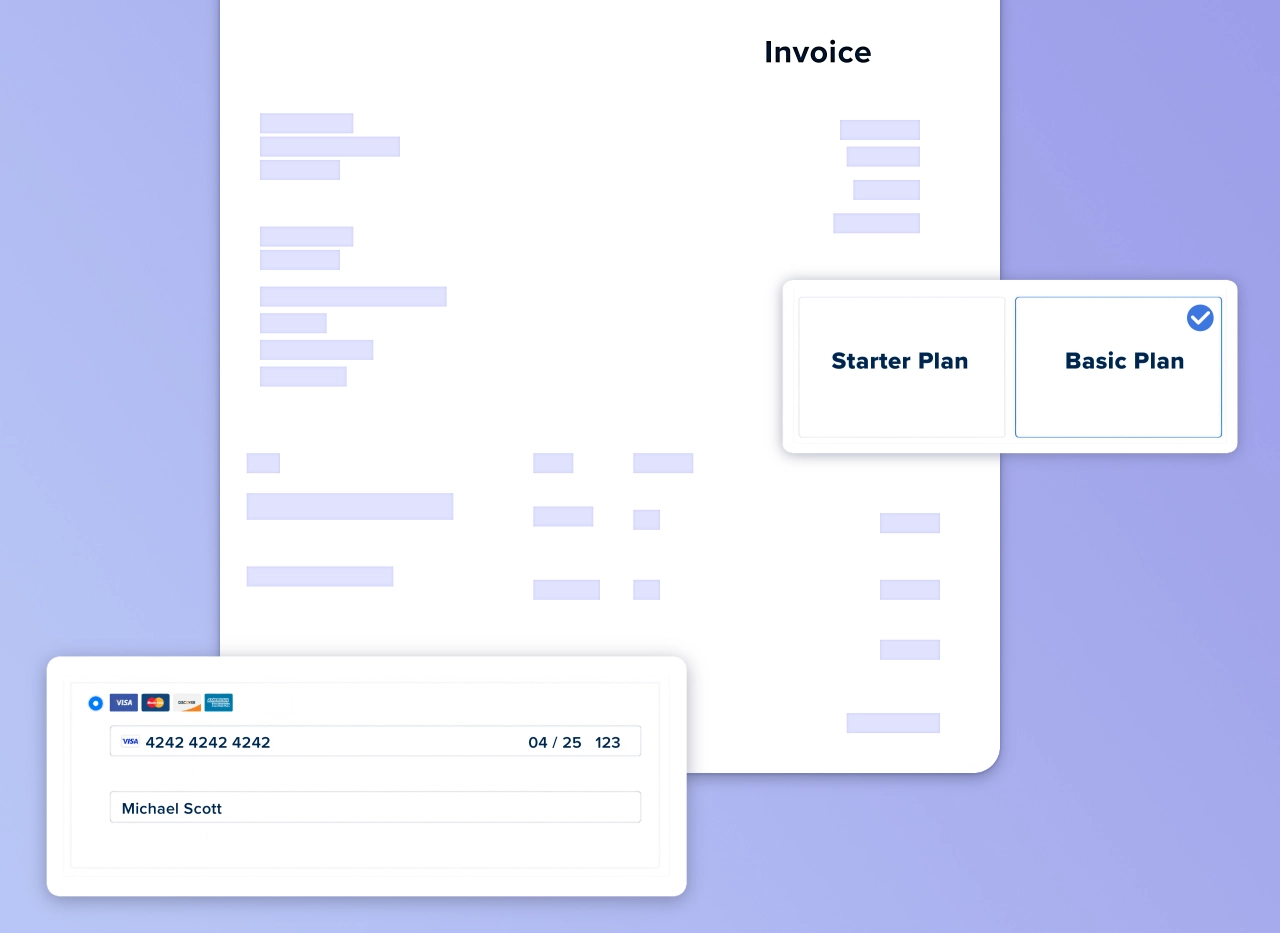
Invoice and collect payments automatically and on time.
Sometimes, perhaps a client feels willing to continue, but is also overwhelmed with other work or decision fatigue. Small nudges can make all the difference. An abandoned cart sequence can win back otherwise lost business—just like in B2C e-commerce.
Clients might benchmark your services against alternatives. What if it was hard to lose the convenience you offer for a more traditional setup?
Over time, your system becomes familiar. The interface itself is sticky.
Be a safe bet & reduce risk for your clients
We tend to assume that clients renew if they feel like they’re getting value.
In real life, there are other dimensions. A client might face uncertainty or their business could be changing direction. Even if they’re convinced of your quality and reliability, that might not be enough. For one reason or another, they might not be able to measure the impact your work has on their OKRs or bottom line.
It’s important to find out what ultimate outcomes your decision-maker has in mind:
How does your work map with overall business strategy? Personal incentives? An urgent problem? Or is it a moonshot experiment?
What’s the opportunity cost of working with you? Both for their organisation and your individual sponsor(s) within the organisation?
What would it mean for them to have paid you, and not get the outcome they were hoping for?
Now you’re thinking about risk.
Simply put, improving the risk profile of your services improves your client retention rate. Besides lower prices, there’s a few ways you can reduce risk for your clients:
Reporting better mapped to OKRs
Shorter or more flexible contracts – or “buy now, use later” credits
Stronger trust, or an understanding that the account is important
In any case, deepen your knowledge of the client’s business. The more you understand their position, the more meaningful you can make your reports. With insight into their calendar and the health of their business, you can be tactical. You can decide if and when to commit extraordinary resources—or to offer flexibility.
The strategy differs slightly between bespoke services and high-volume agencies.
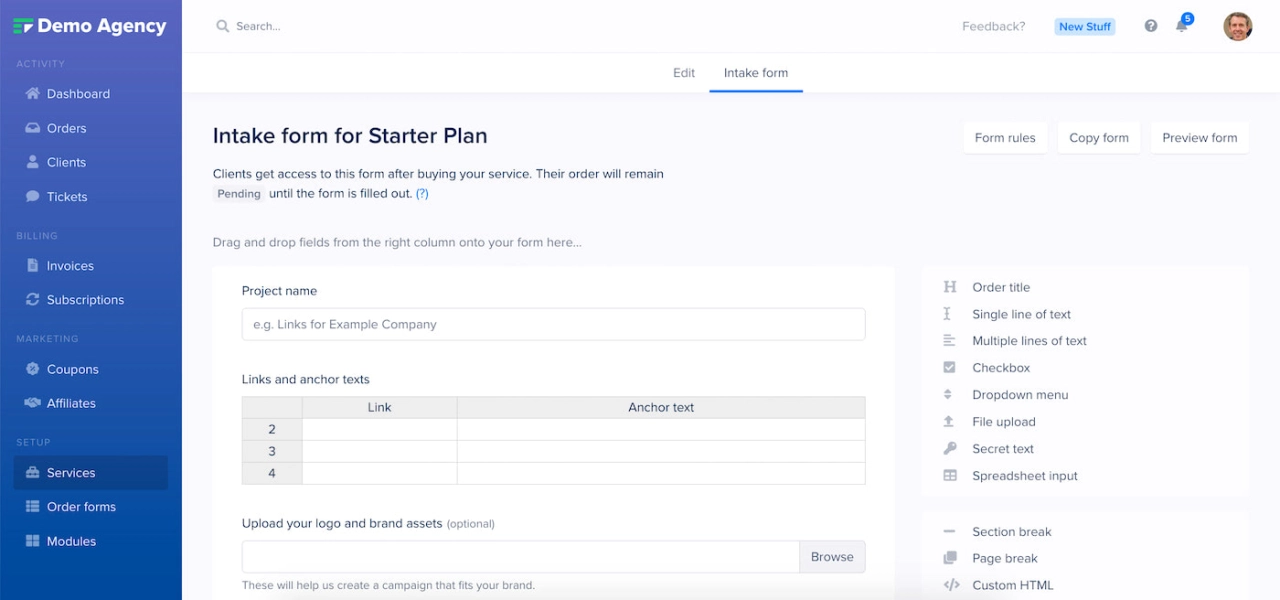
In the case of premium consulting, it’s up to account managers to ask better questions. For productized agencies, it’s about rigorous and effective data intake processes. These can be automated.
Guide clients into giving you actionable feedback
Getting specific and detailed feedback from clients is vital. It’s also easy to take for granted.
Clients know that giving good feedback helps them receive a better service. But articulating useful information for partners can be uncomfortable and laborious.
Without a framework, you’re likely to be drip-fed commentary that doesn’t clarify client priorities. Rushing to find out that they are basically satisfied exacerbates the problem.
To get actionable information, you must be methodical. Ask the right questions at the right time.
Explain the character of feedback appropriate for each stage of the engagement. For example: abstract and strategic in the beginning, granular and executional later. Ask individuals to separate their subjective opinions from actual clarifications of the brief.
If there are many stakeholders, establish a responsible party on the client team. They must synthesise different views into a unified client voice.
These principles apply whether your services are bespoke or productized. The difference is simply whether to develop a methodology for account managers to follow, automate it with templates and software, or a combination of both.
In any case, switching back and forth between email, forms, and project assets is a chore. So put all your client communication and project information in one place. This makes providing feedback much easier.

If a client leaves, finding out why should be a priority. That’s no easy task; if they’re no longer invested they may prefer the painless approach. You must persuade them to divulge their decision-making process. This is some of the most valuable data your agency will ever get.
Of course, long-term clients also give better feedback. The benefits of getting this right are multiplicative over time.
Communicate well & make yourself understood
If you offer bespoke services, your touchpoints will generally be personal. However, if you’re developing a low-cost productized model, a lot of client contact is automatable.
Either way, quality of communication has an enormous impact. The level of automation might be different, but quality is universal. It affects both client experience, and your effectiveness.
What does high quality agency-client communication look like?
The first attribute is a steady rhythm of contact, without long gaps. Design a communications schedule with touchpoints at fixed intervals. Keep clients accountable and engaged, with notifications and reminders when necessary. These can be automated without undermining that personal connection. Just set them up to come from your own website domain.
Secondly, expectations must be clear. For bespoke consultancies, establishing boundaries requires ongoing vigilance. It’s all-too-easy to overpromise. Small misunderstandings can slip through the net and butterfly into significant problems later. Productization offers an advantage here. You can frontload the effort of precisely defining the scope of work for each engagement type.
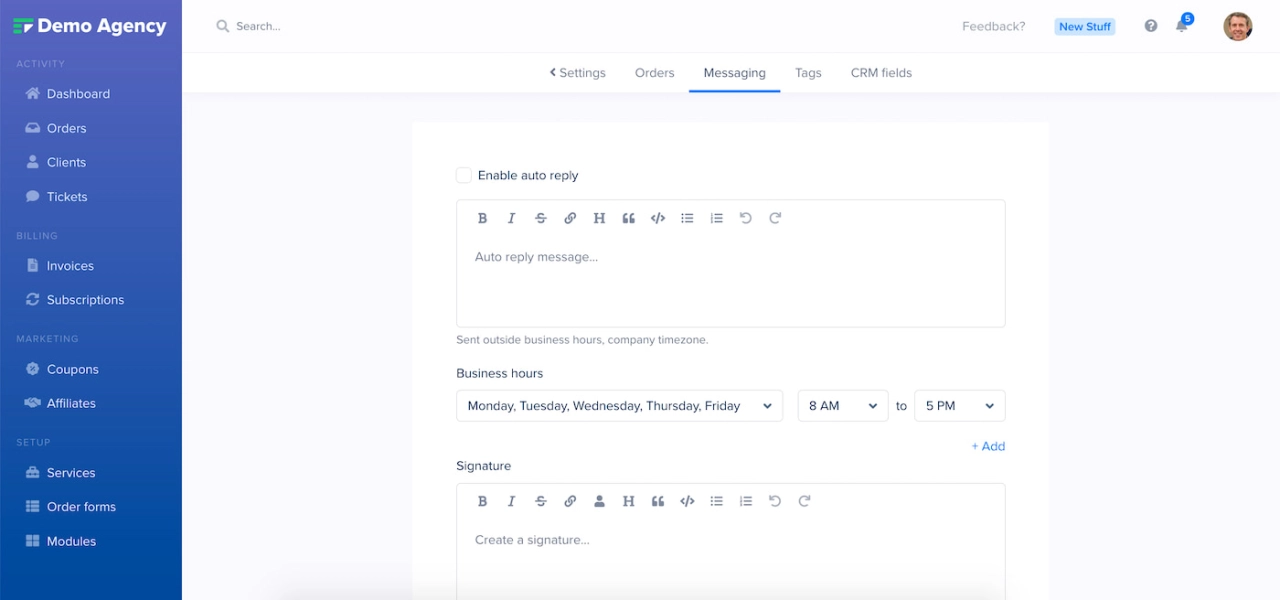
But productized or not, it’s wise to systemise some essential processes. Setting up automated out-of-hours replies protects your schedule and establishes norms for responsiveness. Using intake forms with automated reminders holds your clients accountable. The result is higher quality information, at kick-off and throughout the engagement.
Thirdly, talking to you should fit naturally into your client’s workflow. Do they have to gather information from many sources? Must they spend mental energy organising their thoughts before they can speak to you? Then their experience and your value is already diminished. Conversations should be comfortable and contextual.
Confusion is likely if you have inconsistent information spread across many communication channels. Where do your clients go to ask for help? How can they check in on progress? What about if they want to provide information? Everything should be in one place. That keeps momentum high and creates an environment where everything is under control.
Send reports your clients will stop and pay attention to
Do you know what purpose your reports serve for your clients?
Or do you default to viewing them as a kind of inspection—the client’s moment to check your work and compare your progress with their expectations?
Don’t assume your client is engaged. People hire agencies to remove things from their plate. If it takes careful scrutiny to make sense of your reports, you’re doing just the reverse.
Some clients really are looking for some quick reassurance from a report. If that’s the case, provide it concisely. Don’t cherry-pick data points or drown the report in metrics that blur reality. Skip the jargon and specialized observations that need interpretation. Keep it laser-focussed on their OKRs.

Other clients need something else entirely. They might be looking for insights to guide their decision-making. Perhaps they need proof points and data to influence others and get buy-in for their ideas. The way to be certain is to ask the client what they want from reports—and how often they’d like to get them.
If your reports are overflowing with data, make it visually compelling. Or better yet, interactive. It should be painless to get the key takeaways a glance. Reporting benefits from a combination of automation and personal touch. Set up automations via APIs to bypass the erratic and labour intensive process of generating reports manually. But don’t leave the client with the impression that reports just come ‘from the system’. Follow up, and treat it as a key action item for the client to read the report.
It’s hard to do great reporting within the limitations of ordinary document sharing. Instead, clients should be able to find everything relevant to working with you in one place. Providing a smoother experience makes your reports more likely to be read. Putting them in the proper context makes them more likely to be understood.
Agency Client Retention FAQ
What is a good retention rate for agency?
The retention rate of an agency highly depends on the service they provide. Those focusing on recurring services have a much higher retention rate than agencies selling one-time services. According to Statista, the top PR agencies have a retention rate of 95–99%.
How do agencies retain clients?
Traditional agencies often work with custom retainers that are tailored to match their client’s needs. Many of them even assign a manager to each client, who needs to ensure that the customer is happy.
What does it mean if an agency has a retention rate of 90%?
If the agency started the reporting period with 10 clients and only one canceled, they are left with 9 paying customers. Therefore, their retention rate is 90%.
Summary
Good clients and bad clients aren’t fixed realities. Being effective at working with external service providers is a business competency. It can be developed, thus giving the client access to more flexibility and capability. If you can be the kind of agency that provides guide rails to your clients, and takes the pain out of developing this competency, you’ll be indispensable.
Low cost is often a key part of the value proposition for productized agencies. It’s a great way to open up market segments that would never be accessible to traditional agencies. But it also means you will attract deal-seekers, who might quickly benchmark you and leave.
To get loyal clients, you have to surprise and delight them. To scale that, you must build repeatable processes. Following these five steps makes it easier for apprehensive clients to keep saying yes. With more time and cooperation, you have a better chance to prove your value.




